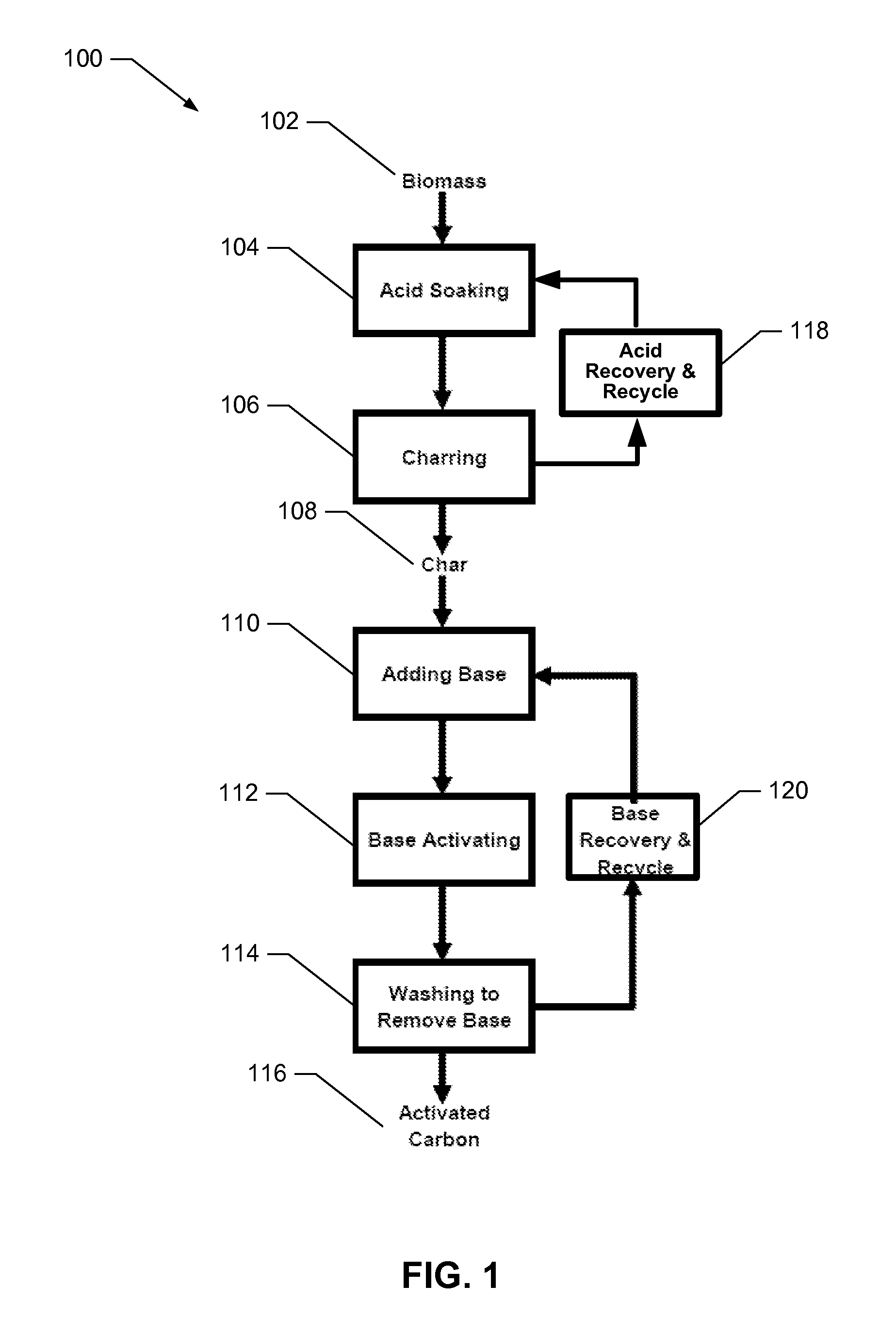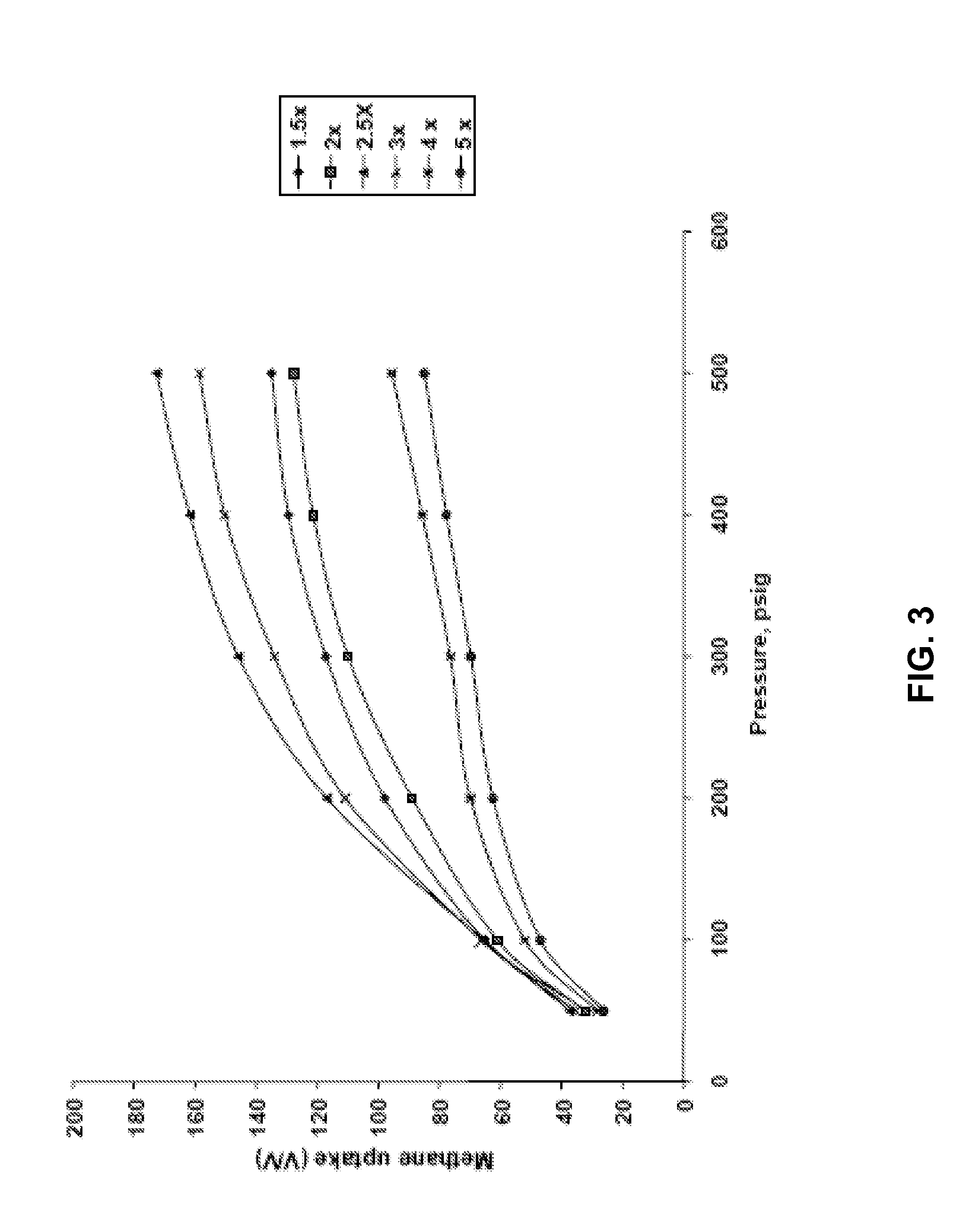High surface area carbon and process for its production
a high surface area, carbon technology, applied in the direction of educts, hydrocarbons, products, etc., can solve the problems of a wide range of processes, a large amount of waste of resources, and a significant lower yield compared to chemical activation methods
- Summary
- Abstract
- Description
- Claims
- Application Information
AI Technical Summary
Benefits of technology
Problems solved by technology
Method used
Image
Examples
example 1
Preparation and Characterization of Preferred Carbon Samples
[0147]A series of experiments were carried out to demonstrate the impact of different parameters (e.g., phosphoric acid treatment and KOH activation) on the final carbon pore volume, pore size distribution, and surface area. For purposes of clarity, the carbon materials prior to base (preferably KOH) activation are referred to as char and after base activation as activated carbon.
[0148]Dried crushed corncobs were mixed with different concentrations of phosphoric acid ranging from 0-70% by volume in the weight ratio of 1:1.5 (grams corn cob: grams phosphoric acid / water solution). This is about a 0.8:1 ratio of acid mass to corn cob mass on a water-free basis. The corn cobs were soaked at different temperatures in phosphoric acid for about 8-10 hrs. After that, the excess of phosphoric acid was removed by heating the mixture at 165-175° C. for 2 hrs. Then the soaked corncobs were carbonized at a constant temperature in the ra...
example 2
Parametric Studies on Charring Process
[0153]Table 2 summarizes the parametric study results on charring with phosphoric acid using 40-60 mesh corn cob stock.
[0154]The C-series demonstrates the impact of phosphoric acid concentration in which higher concentrations of phosphoric acid lead to higher surface areas for the char that is produced. This charring step consistently produces a char with a BET surface area of at least 900 m2 / g.
[0155]The ST-series demonstrates the impact of acid soaking temperature. Soak temperatures greater than 80° C. dramatically decreased the BET surface area and increased char density.
[0156]The HTT-series demonstrates the impact of charring temperature in which exceeding higher charring temperatures results in decreased micropore volumes and decreased surface areas. Charring temperatures near 450° C. consistently produced a char with a BET surface area of at least 900 m2 / g. Charring temperatures above about 450° C. decreased surface areas and micropore volu...
example 3
Parametric Studies on Activation Process
[0159]Table 3 summarizes parametric study results on activation with KOH. The default process conditions of Example 1 apply.
[0160]The KC-series demonstrates how KOH:char ratios in excess of 2.0 may be used to attain BET surface areas in excess of 3000 m2 / g. Density decreased with increasing KOH:char ratios. Micropore volume decreased at KOH:char ratios greater than 3.0. The samples were activated at a temperature of 800° C. for 1 hour. The char used for this activation was soaked with 50% phosphoric acid at 50° C. for 8 hours, charred at 450° C., and heated to charring temperature at 1° C. / min. FIGS. 3, 4, and 5 illustrate the impact of pressure (methane and nitrogen) on adsorption.
[0161]The Ba-series re-evaluates the KOH:char ratios with an emphasis on methane uptake. Preparation conditions in addition to those listed in Table 1 included use of 20-40 mesh corn cob feedstock, a 24 hr soak time, heating at 1.5° C. / min to the charring temperatur...
PUM
| Property | Measurement | Unit |
|---|---|---|
| temperature | aaaaa | aaaaa |
| temperature | aaaaa | aaaaa |
| temperature | aaaaa | aaaaa |
Abstract
Description
Claims
Application Information
 Login to View More
Login to View More - R&D
- Intellectual Property
- Life Sciences
- Materials
- Tech Scout
- Unparalleled Data Quality
- Higher Quality Content
- 60% Fewer Hallucinations
Browse by: Latest US Patents, China's latest patents, Technical Efficacy Thesaurus, Application Domain, Technology Topic, Popular Technical Reports.
© 2025 PatSnap. All rights reserved.Legal|Privacy policy|Modern Slavery Act Transparency Statement|Sitemap|About US| Contact US: help@patsnap.com



